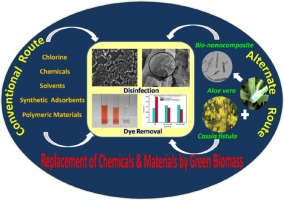Journal of Environmental Management ( IF 8.7 ) Pub Date : 2018-08-13 , DOI: 10.1016/j.jenvman.2018.08.028 Saumaya Kirti , Vinay M. Bhandari , Jyotsnarani Jena , Arnab S. Bhattacharyya

|
In the present study, two synthesis methods of nanocomposites-one involving a mixture of biomass and the other using chemical modification were investigated to evaluate practical application of green approach in pollution control, specifically for water and wastewater treatment. Newer multifunctional superparamagnetic nanocomposites using biomaterials such as unripened fruit of Cassia fistula (Golden shower) and Aloe vera were developed as an example of green approach while chemical modification was illustrated using n-octanol. Two specific model applications were studied for the developed materials-dye removal (Methyl Blue and Congo Red) and disinfection-demonstrating antimicrobial property. To elucidate the multifunctional character, the texture, morphology and composition of the prepared bionanocomposites were studied. The surface area values were 6.2 and 9.8 m2/g for Aloe vera and octanol based nanocomposites while the average pore diameters were 1.79 nm and 5.7 nm respectively, indicating presence of highly developed micropores in the first material having a honeycomb shape and the later showing excellent staircase type formation with larger pores. A very high dye removal to the extent of 100% was obtained that can be attributed largely to the functionalities imparted from Cassia fistula compared to ingredients from Aloe vera and octanol. The nanomaterials could be completely separated with absolute ease by applying simple magnetic field. Also, successful application of the developed materials in disinfection, removal of E. coli, was demonstrated with a very high efficiency of over 95%. The biomass derived nanocomposites exhibit excellent pollutant removal and disinfection properties, even at very low nanoparticle content; octanol based material indicating ∼5 times lowered cost, while the Aloe vera based bionanocomposites have potential for cost reduction to the extent of 10 times as compared to only magnetite nanoparticles, thereby highlighting techno-economical alternative in water and wastewater treatment.
中文翻译:

阐明生物质衍生的纳米复合材料在水和废水处理中的功效
在本研究中,研究了两种纳米复合材料的合成方法,一种涉及生物质的混合物,另一种采用化学改性,以评估绿色方法在污染控制中的实际应用,特别是在水和废水处理方面。使用生物材料的新型多功能超顺磁性纳米复合材料,例如决明子的未成熟果实(金色淋浴)和芦荟开发了绿色方法的示例,同时使用正辛醇对化学修饰进行了说明。研究了两种特定的模型应用,用于开发的材料染料去除(甲基蓝和刚果红)和消毒剂,展现出抗菌性能。为了阐明其多功能性,研究了所制备的生物纳米复合材料的质地,形态和组成。芦荟的表面积分别为6.2和9.8 m 2 / g纳米复合材料和辛醇基纳米复合材料的平均孔径分别为1.79 nm和5.7 nm,这表明第一种材料具有蜂窝状,而后一种材料则形成了高度发达的微孔,形成了较大的孔,从而形成了高度发达的微孔。与芦荟和辛醇的成分相比,获得了非常高的染料去除率,达到100%的程度,这在很大程度上归因于决明子瘘赋予的功能。通过施加简单的磁场,可以绝对轻松地将纳米材料完全分离。此外,已成功将开发的材料应用于消毒,去除大肠杆菌,被证明具有超过95%的极高效率。即使在非常低的纳米颗粒含量下,生物质衍生的纳米复合材料仍具有出色的污染物去除和消毒性能。辛醇基材料的成本降低了约5倍,而芦荟基的生物纳米复合材料的成本却比仅磁铁矿纳米颗粒降低了10倍,因此在水和废水处理中突出了技术经济的替代方法。


























 京公网安备 11010802027423号
京公网安备 11010802027423号